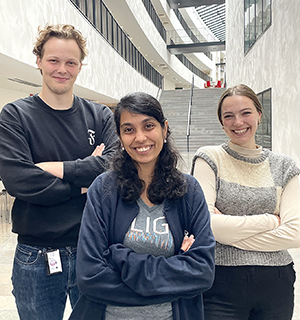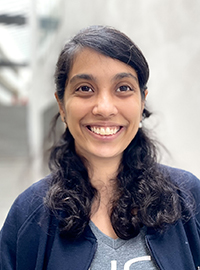Quantum keys can keep our secrets safe

Your bank login, your health data, even your private messages – all rely on encryption. But future quantum computers could crack them in seconds. To stay ahead, researchers at KTH are turning to quantum physics itself, developing technology that keep our communication secure for decades to come.
Imagine someone suddenly hijacking your online bank. All your passwords, all the encrypted messages
you’ve ever sent – laid bare, like postcards in the mail. It sounds like science fiction, but as p owerful quantum computers edge closer to reality, that scenario may not be far off.
“Today’s encryptions are based on mathematical algorithms that are tough for today’s computers to crack. But once quantum computers are up and running, they’ll be capable [HK1] to solve them within seconds,” says Hilma Karlsson, PhD student in a research group led by KTH’s Vaishali Adya.
At AlbaNova in Stockholm – the hub of KTH’s quantum research – Adya and her two colleagues are developing technology that could secure tomorrow’s information flows. And it’s not only online banking at stake, the trio stresses. Anything encrypted today is vulnerable: WhatsApp messages, money transfers, health records, or classified communication between government offices.
“Already now, attackers have the capability to steal encrypted data to store it, waiting for the day quantum computers can break it. That’s what we call ‘harvest now, decrypt later’,” says Vaishali Adya.
New encryptions methods
This creates a ticking clock. “If you need to keep your data secure for 50 years, and quantum computers arrive in 30, you need to start encrypting differently – now,” explains Erik Svanberg, PhD student in the group.
So how do you outsmart the most powerful computers ever built? By turning to quantum physics itself.
“Instead of relying on algorithms, we want to use the laws of quantum physics to create the cryptographic keys. In theory, they’re completely unbreakable,” says Hilma Karlsson.
The method is called quantum key distribution (QKD). Importantly, it’s not the information itself that is sent using quantum physics, but the key – the shared secret that lets two parties lock and unlock a message. QKD works because of a fundamental quantum principle:
“If you generate a quantum state and measure it, you collapse the state,” explains Vaishali Adya. “If a third party tries to eavesdrop, it will leave detectable traces.”
QKD information is carried by light, but quantum signals are always affected by unavoidable hissy background noise. The KTH group is exploring how to make QKD more efficient using a special form of light called squeezed light, that redistributes that noise so it matters less.
“Squeezing is just a very elegant way of redistributing this unwanted hissy noice,” says Adya. She illustrates by taking a cardboard paper roll and pressing it flat. The roll doesn’t disappear, but its shape changes: narrower in one direction, wider in the other. “This allows us to manipulate the wave-like properties of light. In the same way, you can measure either the light’s amplitude very precisely, or its phase – but not both at once. That’s the Heisenberg uncertainty principle*,” says Adya.

By shifting the uncertainty, squeezed light makes the part of the signal of interest stand out more clearly. This allows the two parties to share a secret key more reliably, while still exposing any attempt at eavesdropping.
National infrastructures in EU
Inside the group’s lab, rows of black, vibration-damped boxes keep the fragile laser beams stable enough not to lose their quantum state. It’s delicate work, but part of a growing movement: more than 200 researchers across Sweden are now working on quantum technologies.
Europe is racing to build quantum-secure communication lines. Each EU member state is setting up a national infrastructure for QKD, to eventually interconnect with others. In Sweden, this initiative is led by KTH’s Katia Gallo and the infrastructure aims at tailoring solutions to the country’s specific needs.
“The area of quantum communication is evolving rapidly – it’s like the transistor era,” says Adya. “And what makes it so fascinating is that it’s not a one-trick pony. QKD is just the start. Specially engineered quantum states of light like the squeezed states can open doors to many other applications, and we don’t yet know how far it can go.”
Text: Anna Gullers

